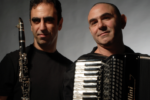Cesar Lerner and Marcelo Moguilevsky are the ideal musical performers to give a concert celebrating Jewish diversity in the Greater Boston area. The two musicians, who hail from Buenos Aires, are this year’s artists-in-residency presented by the Jewish Arts Collaborative. With Lerner on keyboard and Moguilevsky playing an array of wind instruments, the two musicians will be performing and participating in conversations in Boston-area venues from Feb. 4-6.
In the four decades the men have been collaborating, their music has combined elements of klezmer, Argentinian folk music, jazz and tango. Lerner and Moguilevsky’s music is also decidedly Jewish, taking into account their grandparents’ immigration to Argentina from Russia and Poland at the turn of the last century.
For over two decades, Lerner and Moguilevsky have also played a significant role in recreating klezmer music for the 21st century. Their album “Klezmer in Buenos Aires,” released in 1997, reflects their journey as Argentinian Jews. Two years later, the duo paid homage to the first Jewish settlers in Argentina with their album “Basavilbaso.” Their music has also staked out new trends in contemporary music through the use of electronic media, loops, flutes, piano, African balafon, gongs, duduk, ney, clarinet, accordion, harmonica, mouth harps, bass drum and voice.
A music critic offered an evocative description of one of the settings in which Lerner and Moguilevsky played their music. He wrote: “I first heard the duo ‘Klezmer en Buenos Aires’ in a Buenos Aires 1940s-vintage corner bar called Cafe Mar Azul. This tiny space, seating a few dozen people, was so packed with standees that night that they opened the big windows so there were more people listening from out on the street than there were inside the jammed bar. The duo’s clarinet and accordion sang out onto the sidewalks until people were dancing on the pavement to the sobbing krekhts and trilling dreylekhs.”
Lerner and Moguilevsky’s most recent album, “Sefarad,” highlights the Sephardic influences in their music. Perhaps because of Ladino’s connection to Spanish, Buenos Aires has loomed particularly large in the Sephardic Jewish imagination. To describe this new musical journey, they have invented a portmanteau, Klezfarad.
As one music critic recently wrote of the duo’s music: “It is not quite Argentinian folk music, jazz, contemporary music or tango. It’s both, some of and all of those things.”









